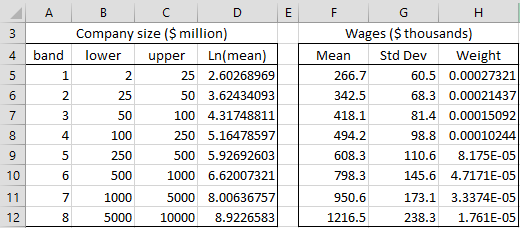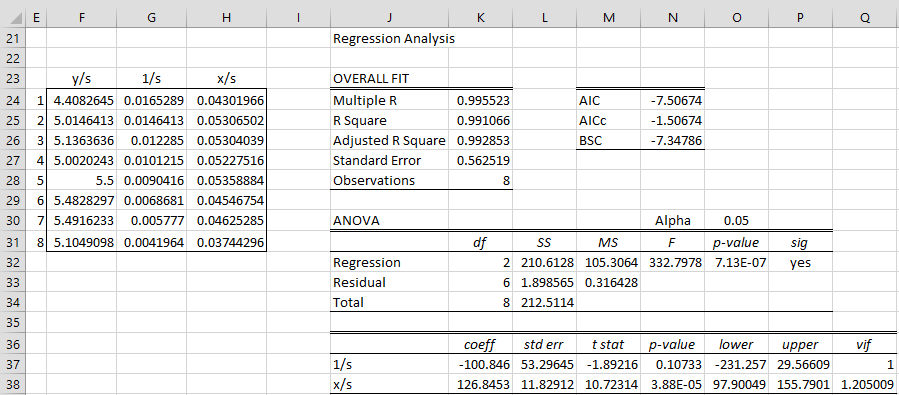Basic Concepts
Suppose that we have data (x11, …, x1k, y1), …, (xn1, …, xnk, yn), where for each i, yi is the mean value of y for all samples whose independent variables have the values xi1, …, xik and σi is the standard deviation of these samples. Now we convert the usual linear regression
into the equivalent form
Since = var(yi) = var(εi), it follows that var(εi/σi) = 1, and so the homogeneity of variance assumption (aka homoscedasticity) of this second model is met. This model has the form
You can find the coefficients of this model using an OLS model without intercept (here = 1/σi).
Example
Example 1: Repeat Example 1 of WLS Regression for Heteroskedasticity using the OLS regression through the origin approach. The example is as follows.
A survey was conducted to compile data about the relationship between CEO compensation and company size. The summarized data from 200 respondents is shown in Figure 1. Create a regression model for this data and use it to predict the wages of a CEO for a company whose annual revenue is $200 million a year.
Figure 1 – Relationship between company size and CEO compensation
We transform the OLS regression mode;
wages = b0 + b1 ∙ LN(mean company size)
into the following OLS regression through the origin form:
wages/stdev = b0/stdev + b1 ∙ LN(mean company size)/stdev
To do this, we transform the data from ranges D4:D12 and F4:G12 of Figure 1 to that shown in range F23:H31 of Figure 2. E.g. the values in cells F24, G24 and H24 are calculated respectively by the formulas =F5/G5, =1/G5 and =D5/G5.
Figure 2 – Dealing with heteroscedasticity using a model without intercept
We next use the Real Statistics Multiple Linear Regression data analysis tool with the without intercept option on the input data in range F23:H31, as described in Regression through the Origin, to obtain the regression analysis shown on the right side of Figure 2. This model takes the form
wages/stdev = -100.846 ∙ stdev + 126.8453 ∙ LN(mean company size)/stdev
or equivalently
wages = -100.846 + 126.8453 ∙ LN(mean company size)
which is the same as that calculated in Figure 2 of WLS Regression for Heteroskedasticity (although many of the other values in that figure are different).
Data Analysis Tool
Real Statistics Data Analysis Tool: The Weighted Linear Regression data analysis tool can also be used to perform WLS regression by using the OLS regression through the origin approach. To do this, just check the Use OLS regression through the origin option shown in Figure 1 of Real Statistics Support for WLS Regression.
Examples Workbook
Click here to download the Excel workbook with the examples described on this webpage.
References
Wikipedia (2018) Weighted least squares
https://en.wikipedia.org/wiki/Weighted_least_squares
Eisenhauer, J. G. (2003) Regression through the origin
https://onlinelibrary.wiley.com/doi/10.1111/1467-9639.00136
Huang, Y. (2021) Weighted least squares
https://www.stat.uchicago.edu/~yibi/teaching/stat224/L14.pdf
Shalizi, C. (2015) Weighted and generalized least squares
https://www.stat.cmu.edu/~cshalizi/mreg/15/lectures/24/lecture-24–25.pdf

